Course
Don't struggle with large datasets. Master the art of grouping and aggregating data using the DAX SUMMARIZE() function, which lets you uncover hidden patterns and make better decisions. With DAX SUMMARIZE(), you can create a mini-report within your larger dataset and pick which information to group and what numbers to add up. It's extremely, extremely helpful.
Keep reading, and I'll help you understand DAX SUMMARIZE() in detail so you can use it effectively in a lot of scenarios. If you’re new to DAX and want more resources, also check out our Power BI DAX Tutorial for Beginners for a more general view. You can also take our Introduction to DAX in Power BI course for real training; the course includes basic but also more advanced techniques, so it's good for professionals at all levels.
What is the DAX SUMMARIZE() Function?
The DAX SUMMARIZE() function takes your data and groups it based on the columns you choose. Then, it calculates totals or other summaries for each group.
For example, suppose you have a big list of sales data with information about products, regions, and sales amounts. Here, you can use SUMMARIZE() to group all that data by product or region and see the total sales for each group.
You'll come across DAX in several Microsoft tools, such as:
- Power BI (it's super popular for business analytics)
- Excel, specifically in Power Pivot
- SQL Server Analysis Services (SSAS)
Once you understand SUMMARIZE(), you can organize your data efficiently by creating better reports and digging deeper into your data for valuable insights. So, next time you're working with a large dataset and need to make sense of it quickly, use the SUMMARIZE() function.
Master Power BI From Scratch
DAX SUMMARIZE() and Data Grouping
Here’s how the SUMMARIZE() function creates summary tables based on specified columns and aggregations:
SUMMARIZE (<table>, <groupBy_columnName>[, <groupBy_columnName>]…[, <name>, <expression>]…)In the above syntax:
-
tableis the source table for your data. -
groupBy_columnNameis the column(s) you want to group by. -
nameis the name for your new calculated column. -
expressionis the calculation you want to perform.
You can use SUMMARIZE() with any table or column in your dataset, which makes it very versatile.
Basic grouping
Let's look at a simple example of basic grouping with SUMMARIZE().
First, import the data set into Power BI. To do so, go to the Home tab > Get Data. Select the option corresponding to your saved file from the dropdown menu and load it. In this example, I have a dataset with columns for Year, Product, and SalesAmount. I’ll now import this to Power BI.
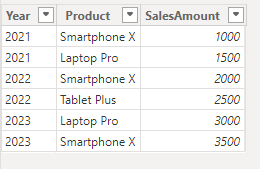
A table named sales. Image by Author.
Once the data is imported, go to the Modeling tab > New table. Then, enter the following formula to group by the Year column and aggregate the Total Sales.
SummaryTable =
SUMMARIZE(
sales,
sales[Year],
"Total Sales", SUM(sales[SalesAmount])
)
Formula bar. Image by Author.
In this formula:
-
SummarizedTablecreates a new table. -
SUMMARIZE(begins grouping and summarizing data. -
SalesData,is the source table. -
SalesData[Year],groups by the Year column. -
"Total Sales", SUM(SalesData[SalesAmount])creates a new column called Total Sales that sums up SalesAmount for each year.
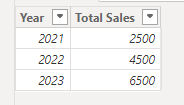
Summarized results. Image by Author.
Here, the SUMMARIZE() function creates a summary table by grouping the data by Year and calculates the Total Sales by summing the SalesAmount for each year.
Multiple grouping
SUMMARIZE() can also handle more complex groupings. Let’s understand this with an example. Here, I have a dataset here with columns for Year, Product, Region, and SalesAmount.

A table named sales_data. Image by Author.
Here, I’m grouping by Year and Region to calculate the Total Sales for each combination.
SummarizedTable =
SUMMARIZE(
sales_data,
sales_data[Year],
sales_data[Region],
"Total Sales", SUM(sales_data[SalesAmount])
)In this formula:
-
sales_datais the table where your data is stored. -
sales_data[Year]is the first column to be grouped by Year. -
sales_data[Region]is the second column to be grouped by Region. -
"Total Sales"is the custom column name for the sum of sales. -
SUM(SalesData[SalesAmount])sums up the sales for each group.
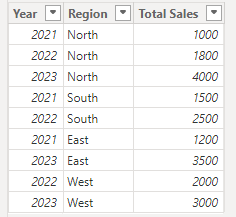
Summarized multiple columns. Image by Author.
Here, multiple grouping helped us visualize sales trends by both Region and Year. The North and East regions display growth from 2021 to 2023. The South had high sales in 2022, while the West only has data for 2022-2023.
Advanced Techniques with DAX SUMMARIZE()
While SUMMARIZE() is helpful, you can combine it with other DAX functions to try even more sophisticated data analysis capabilities. So, let's explore some examples to see how advanced techniques can leverage SUMMARIZE() for complex aggregations and summaries.
Using SUMMARIZE() with ROLLUP()
The ROLLUP() feature within SUMMARIZE() adds subtotal rows to your summary tables to show subtotals across different grouping levels and provide more detailed hierarchical summaries. If you work in the finance field or any relevant analysis role, this would be particularly useful for performing multi-level aggregations.
-
Add the
ROLLUP()keyword after your grouping columns inSUMMARIZE(). -
Specify which columns should be included in the
ROLLUP()calculation.
SUMMARIZE(<table>, <groupBy_columnName>[, <groupBy_columnName>]…[, ROLLUP(<groupBy_columnName>[,< groupBy_columnName>…])][, <name>, <expression>]…)For example, this dataset shows the Sales and Quantity of each Product in a particular Region. Now, I have to find the sales summary by Region and Product, with subtotals and totals.
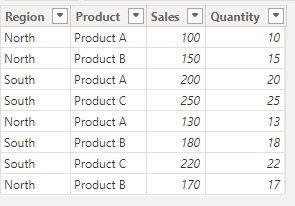
A table named sales_rollup. Image by Author.
To do so, I use the following formula:
SalesWithRollup =
SUMMARIZE(
sales_rollup,
ROLLUP(sales_rollup[Region], sales_rollup[Product]),
"Total Sales", SUM(sales_rollup[Sales]),
"Total Quantity", SUM(sales_rollup[Quantity])
)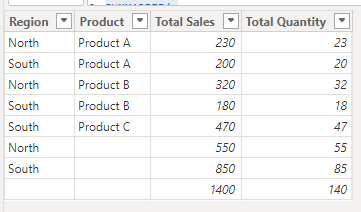
Using the ROLLUP() function. Image by Author.
You can see — here the SUMMARIZE() function groups sales data by Region and Product to calculate Total Sales and Total Quantity. ROLLUP() adds subtotal and grand total rows to give a hierarchical summary of sales performance across different levels of detail.
Combining SUMMARIZE() with ADDCOLUMNS()
You can also extend SUMMARIZE() with ADDCOLUMNS() to include custom-calculated columns within the grouped data. This can be helpful if you want to add measures or complex calculations to your summary table.
For example, I use the same dataset and apply the following formula to add a new column this time:
SalesWithAddColumns =
ADDCOLUMNS(
SUMMARIZE(
sales_rollup,
sales_rollup[Region],
sales_rollup[Product],
"Total Sales", SUM(sales_rollup[Sales]),
"Total Quantity", SUM(sales_rollup[Quantity])
),
"Average Sales per Unit",
DIVIDE(SUM(sales_rollup[Sales]), SUM(sales_rollup[Quantity]), 0)
)
Combining SUMMARIZE() and ADDCOLUMNS(). Image by Author.
Here, the SUMMARIZE() function groups sales by Region and Product to calculate Total Sales and Total Quantity. ADDCOLUMNS() then calculates the Average Sales per Unit by dividing total sales by the total quantity for each group.
Common DAX Issues and How to Resolve Them
When using SUMMARIZE(), you might encounter a few issues. But don't worry we’ve all been there — I'll walk you through some common challenges and how to tackle them.
Avoiding ambiguous results
Sometimes, SUMMARIZE() may give you results that don't quite make sense. This often happens when your data model or relationships aren't clear. Here's how to avoid this:
-
Double-check your data model: Make sure all your tables are connected correctly.
-
Use clear column names: Avoid duplicate names across different tables.
-
Specify table names: When referring to columns, include the table name (like
Orders[OrderDate]) to avoid confusion.
Performance considerations
Although SUMMARIZE() is a helpful function, it can be resource-intensive and slow things down when processing large datasets. This means your reports can take a little longer to refresh, especially if you're using the function within complex measures or with lots of grouped columns.
Here are some tips to keep your queries speedy:
-
Consider calculated columns: For frequently used summaries, create calculated columns instead of using
SUMMARIZE()each time. -
Remove unnecessary columns: Eliminate columns irrelevant to your analysis, such as primary keys or columns that can be calculated from others.
-
Use filters: Use DAX
SUMMARIZE()withFilter()before summarizing to reduce the amount of data processed.
DAX Alternatives to SUMMARIZE()
While SUMMARIZE() is a useful function, sometimes other tools might do the job better. Let's look at a couple of alternatives and when you might want to use them.
SUMMARIZECOLUMNS()
SUMMARIZECOLUMNS() is another DAX function that makes it easier to create summary tables when working with big data or complicated situations. It's similar to SUMMARIZE(), but with some differences.
-
You can add filters directly to
SUMMARIZECOLUMNS(), which makes it faster. -
With
SUMMARIZECOLUMNS(), you can include measures directly in your output. There is no need for extra functions likeADDCOLUMNS(). -
SUMMARIZECOLUMNS()deals with blank rows automatically, so you don't have to worry about them.
SUMMARIZECOLUMNS(
<groupBy_columnName> [, <groubBy_columnName>] …, [<filterTable>] … [, <name>, <expression>] …
)For example, I have a dataset, and I want to summarize employee salaries by Region and Department while filtering for employees with the first name Raven. I will use the SUMMARIZECOLUMNS() function to calculate the total salary for Raven across different regions and departments.
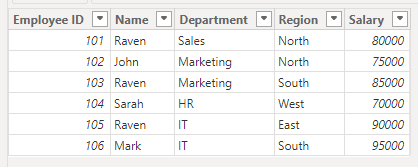
A table named employee_data. Image by Author.
For this, I use the following formula:
SalarySummary =
SUMMARIZECOLUMNS(
employee_data[Name],
employee_data[Region],
employee_data[Department],
FILTER(employee_data, employee_data[Name] = "Raven"),
"Total Salary", SUM(employee_data[Salary])
)In the above formula:
-
SalarySummaryis the name given to the calculated table being created. -
SUMMARIZECOLUMNS(...)creates a summary table based on the specified columns and calculations. -
employee_data[Name], employee_data[Region], employee_data[Department]are the columns by which the data will be grouped. -
FILTER(employee_data, employee_data[Name] = "Raven")restricts the results to only include rows where the Name is Raven. -
"Total Salary", SUM(employee_data[Salary])creates a calculated column in the result. -
SUM(employee_data[Salary])calculates the sum of all Salary values for each group.

Use SUMMARIZECOLUMNS to summarize the results. Image by Author.
You can see the results — the SUMMARIZECOLUMNS() function filters through the dataset and calculates Raven's salary totals across different locations and departments.
GROUPBY()
GROUPBY() is another function that can sometimes replace SUMMARIZE() when you just need to group data and perform calculations on those groups. It can be more efficient than SUMMARIZE() for simple grouping operations.
While SUMMARIZE() can work across related tables, GROUPBY() focuses on grouping and aggregating within a single table, which improves performance in certain scenarios.
Let's see an example. I’ve to create an inventory dataset to track items, categories, units sold, and unit prices, then group the data by category to calculate the total revenue for each.

Inventory table. Image by Author.
For this, I use the following formula:
SummaryGroupBY =
GROUPBY(
Inventory,
Inventory[Category],
"Total Revenue",
SUMX(
CURRENTGROUP(),
Inventory[Units Sold] * Inventory[Unit Price]
)
)In the above formula:
-
GROUPBY()groups the data by Category. -
CURRENTGROUP()refers to each category group (e.g. electronics, furniture or appliances). -
SUMX()calculates the total revenue for each group by multiplying Units Sold with Unit Price.
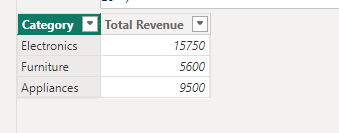
Using GROUPBY to group the data. Image by Author.
You can see — the GROUPBY() function easily calculates the Total Revenue by multiplying Units Sold by Unit Price for each item in the category and summarizing these individual revenues.
Final Thoughts on DAX SUMMARIZE()
You now know how the SUMMARIZE() function in DAX can help you group and analyze data in Power BI, Excel, and other tools. From basic grouping to advanced techniques like ROLLUP() and ADDCOLUMNS(), SUMMARIZE() helps create insightful summaries.
Since practice makes perfect, try these techniques with your own data to see how they can help you uncover useful insights. If you want to polish your DAX skills further, enroll in our Introduction to DAX in Power BI to become a real power user.
Become a Power BI Data Analyst
Master the world's most popular business intelligence tool.
I'm a content strategist who loves simplifying complex topics. I’ve helped companies like Splunk, Hackernoon, and Tiiny Host create engaging and informative content for their audiences.
DAX Summarize() FAQs
Is SUMMARIZE() case-sensitive?
DAX is generally case-insensitive, so the column names used in SUMMARIZE() do not need to match the case of the original data.
What are common errors when using SUMMARIZE()?
Common errors include syntax errors, non-existent column names, and performance issues with large datasets. To avoid these issues, always double-check the function's arguments and your data model.
How do SUMMARIZE() and SUMMARIZECOLUMNS() differ in terms of context?
SUMMARIZE() retains both row and filter contexts for aggregations, while SUMMARIZECOLUMNS() only has a filter context.


